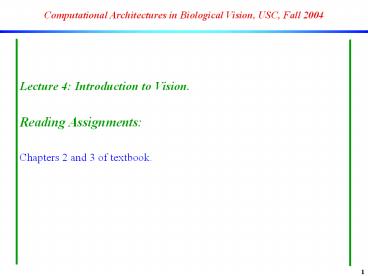Computational Architectures in Biological Vision, USC, Fall 2004 - PowerPoint PPT Presentation
Title:
Computational Architectures in Biological Vision, USC, Fall 2004
Description:
... Organization of the primate retina Trading ... domain Reconstruction Aliasing Sampling Theorem Aliasing Eye Anatomy Visual Pathways Image Formation ... – PowerPoint PPT presentation
Number of Views:90
Avg rating:3.0/5.0
Title: Computational Architectures in Biological Vision, USC, Fall 2004
1
Computational Architectures in Biological Vision,
USC, Fall 2004
- Lecture 4 Introduction to Vision.
- Reading Assignments
- Chapters 2 and 3 of textbook.
2
Todays lecture
- The challenges
- Optics and image formation
- Sampling and image representation
- Theoretical limits
- The biological approach
- Organization of the primate retina
- Trading accuracy for coverage moving eyes
- The engineering approach
- Arrays of photosensitive sensors
- On-board processing and VLSI sensors
- Trading accuracy for coverage multiple moving
cameras
3
Projection
4
Projection
5
Convention Visual Angle
- Rather than reporting two numbers (size of object
and distance to observer), we will combine both
into a single number - visual angle
- e.g., the moon about 0.5deg visual angle
- your thumb nail at arms length about 1.5deg
visual angle - 1deg visual angle 0.3mm on retina
6
Charge-Coupled Devices
- Uniform array of sensors
- Very little on-board processing
- Very inexpensive
7
Optics limitations acuity
8
Sampling
9
Sampling
10
Sampling
11
The Big Question
12
Convolution Fourier Transforms
13
Sampling in the frequency domain
14
Reconstruction
15
Aliasing
16
Sampling Theorem
17
Aliasing
18
Eye Anatomy
19
Visual Pathways
20
Image Formation
Accomodation ciliary muscles can adjust shape of
lens, yielding an effect equivalent to
an autofocus.
21
Phototransduction Cascade
- Net effect light (photons) is transformed into
electrical (ionic) current.
22
Rods and Cones
- Roughly speaking 3 types of cones, sensitive to
red, green and blue.
23
Processing layers in retina
24
Retinal Processing
25
Center-Surround
- Center-surround organization neurons with
receptive field at given location receive
inhibition from neurons with receptive fields at
neighboring locations (via inhibitory
interneurons).
26
Early Processing in Retina
27
Color Processing
28
Over-representation of the Fovea
- Fovea central region of the retina (1-2deg
diameter) has much higher density of receptors,
and benefits from detailed cortical
representation.
29
Fovea and Optic Nerve
30
Blind Spot
31
Retinal Sampling
32
Retinal Sampling
33
Seeing the world through a retina
34
Now with actual eye movements
- Here is a video clip we recorded eye movements
while observers watched it
35
(No Transcript)
36
Shifted to eye position
37
(No Transcript)
38
Sampling Optics
Because of blurring by the optics, we cannot see
infinitely small objects
39
Sampling optics
The sampling grid optimally corresponds to the
amount of blurring due to the optics!































